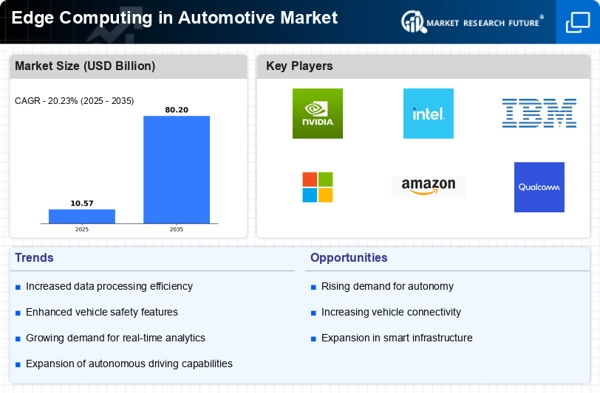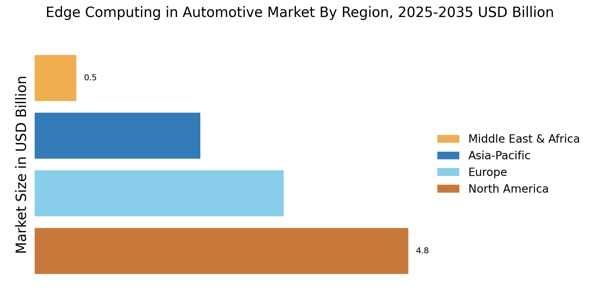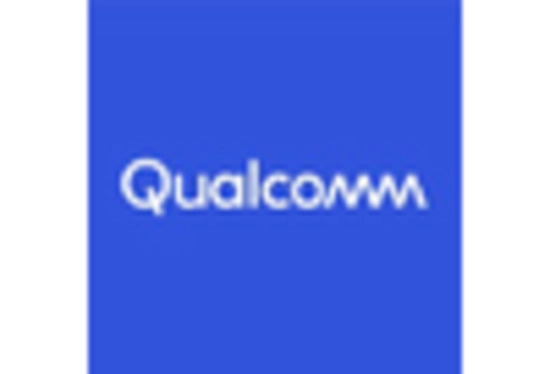Increased Focus on Cybersecurity
As vehicles become more connected, the Edge Computing in Automotive Market faces heightened concerns regarding cybersecurity. The integration of edge computing can enhance the security of automotive systems by enabling localized data processing and reducing the risk of data breaches. By processing sensitive information closer to the source, edge computing minimizes the potential attack surface for cyber threats. The automotive cybersecurity market is projected to reach USD 5.5 billion by 2025, reflecting the industry's commitment to safeguarding vehicle data. This focus on cybersecurity is likely to drive investments in edge computing technologies, as manufacturers seek to protect their vehicles from potential vulnerabilities. Thus, the Edge Computing in Automotive Market is expected to evolve in response to these cybersecurity challenges, fostering the development of more secure automotive systems.
Advancements in Machine Learning and AI
The Edge Computing in Automotive Market is increasingly influenced by advancements in machine learning and artificial intelligence (AI). These technologies enable vehicles to analyze data in real-time, enhancing functionalities such as predictive maintenance, driver behavior analysis, and personalized user experiences. The integration of edge computing allows for efficient processing of AI algorithms directly within the vehicle, reducing the need for constant cloud connectivity. The AI market in automotive is projected to reach USD 10 billion by 2025, indicating a strong potential for growth. As manufacturers seek to leverage these technologies, the Edge Computing in Automotive Market is likely to expand, driven by the demand for smarter, more autonomous vehicles that can learn and adapt to their environments.
Rise of Electric and Connected Vehicles
The Edge Computing in Automotive Market is significantly influenced by the rise of electric and connected vehicles. As the automotive sector transitions towards electrification, the need for efficient data management becomes paramount. Edge computing facilitates the processing of vast amounts of data generated by electric vehicles, enhancing their performance and user experience. Furthermore, connected vehicles require seamless communication with infrastructure and other vehicles, which edge computing can support by reducing latency and improving reliability. The market for electric vehicles is expected to grow at a compound annual growth rate of 22% through 2025, suggesting a substantial opportunity for edge computing solutions. This trend indicates that the Edge Computing in Automotive Market will likely expand as manufacturers integrate these technologies into their electric and connected vehicle offerings.
Regulatory Support for Smart Mobility Solutions
The Edge Computing in Automotive Market is benefiting from increasing regulatory support for smart mobility solutions. Governments worldwide are implementing policies that encourage the adoption of innovative technologies in the automotive sector. These regulations often promote the use of edge computing to enhance traffic management, reduce emissions, and improve overall transportation efficiency. For instance, initiatives aimed at reducing urban congestion and promoting sustainable transport solutions are likely to drive the demand for edge computing applications in vehicles. As cities adopt smart infrastructure, the need for real-time data processing becomes critical, positioning edge computing as a vital component of future mobility solutions. This regulatory environment suggests that the Edge Computing in Automotive Market will continue to grow as stakeholders align with governmental objectives.
Growing Demand for Advanced Driver Assistance Systems
The Edge Computing in Automotive Market is experiencing a surge in demand for Advanced Driver Assistance Systems (ADAS). These systems rely heavily on real-time data processing to enhance vehicle safety and performance. As consumers increasingly prioritize safety features, the integration of edge computing allows for faster data analysis and decision-making. According to recent estimates, the ADAS market is projected to reach USD 67 billion by 2025, indicating a robust growth trajectory. This growth is likely to drive the adoption of edge computing technologies, as they enable vehicles to process data locally, reducing latency and improving response times. Consequently, the Edge Computing in Automotive Market is poised to benefit from this trend, as manufacturers seek to incorporate advanced safety features into their vehicles.


















Leave a Comment